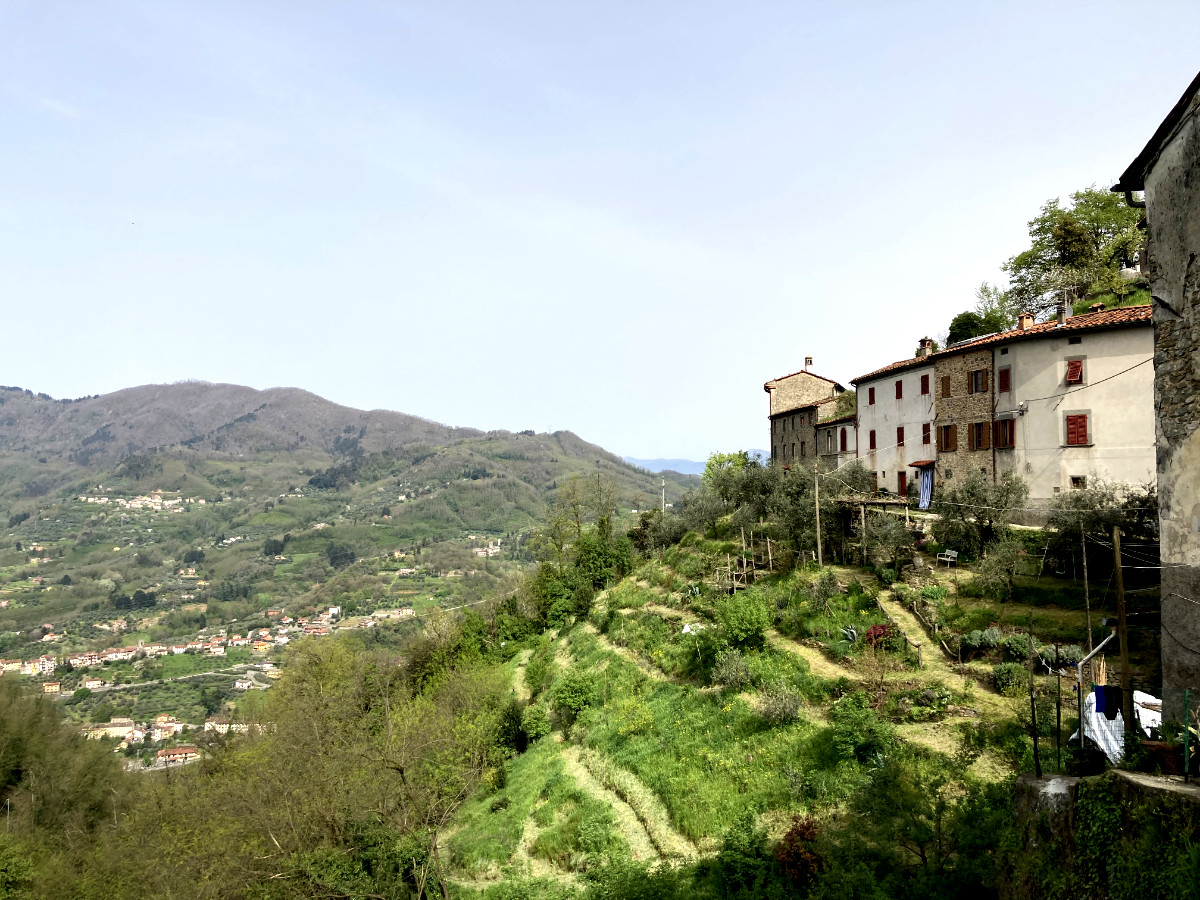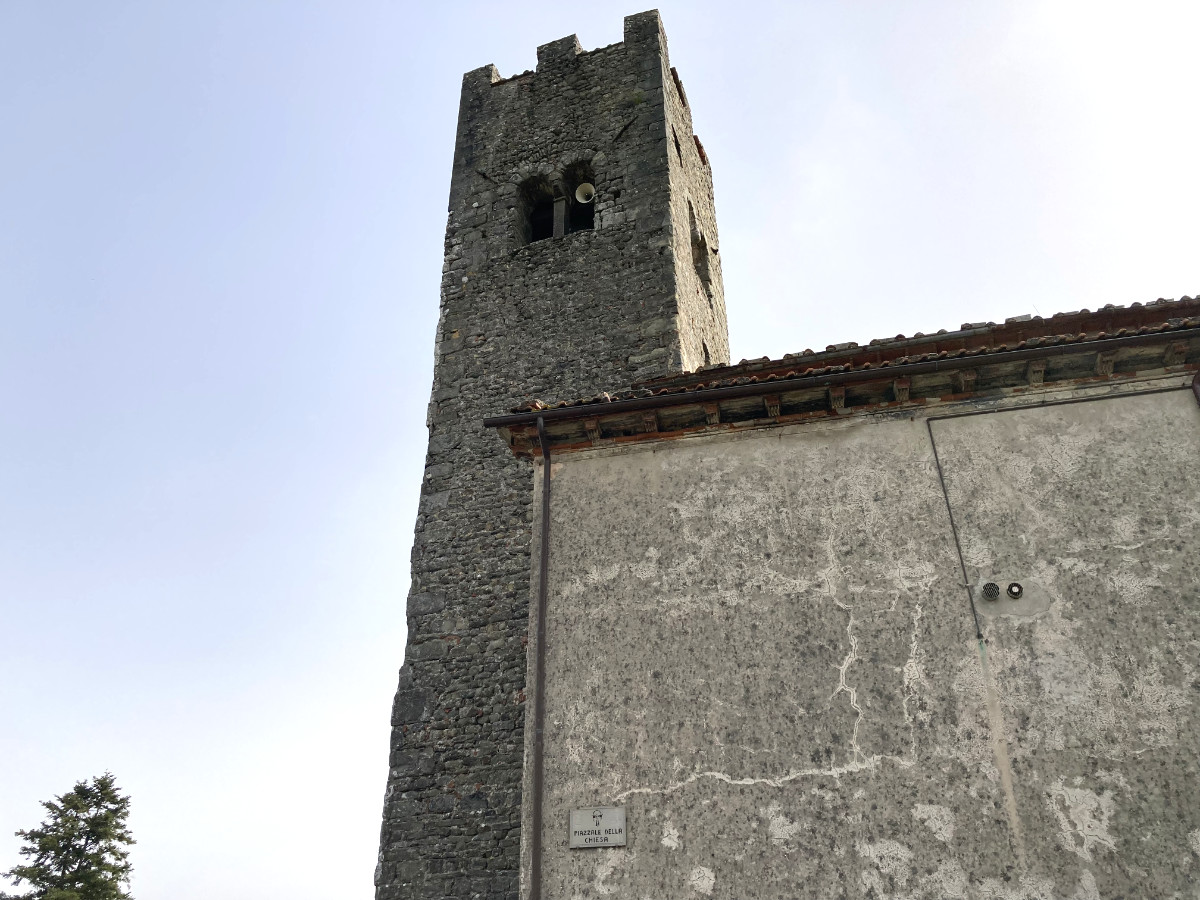
Corsagna is the most populated hilltop village in the municipality of Borgo a Mozzano and is located on the slopes of the Pizzorne plateau at about 400 meters above sea level,
dominating the Serchio River Valley.
The village of Corsagna is quite spread out, characterized by many courtyards and consists of various rioni 1 (quarters): Pozzo, Verace, Postabbio, Fucina, Piazza, Cantone,
Fabbriche and Lama.
The ideal itinerary allows you to discover the beautiful stone houses and courtyards that still characterize the oldest areas such as Fucina, the first rione on the south arriving from
Borgo a Mozzano.
In just a few minutes on foot, you can reach Piazza XX Settembre, visit characteristic Cantone with its houses perched on the hill, and head toward the upper part of the village by way of Via Postabbio. The old Corte (courtyard) Papèra tells us of the medieval past of the village with its stately buildings, then it is on toward Verace and the rione of Pozzo,
located in the highest part of the village.
The Church of San Michele dominates the entire village and its stone bell tower stands where an ancient castle used to guard the fief and the Serchio River Valley.
Also not to be missed is the rione of Le Fabbriche, born as an industrial area, already in the Middle Ages, for the production of iron taking advantage of the water power of a canal
to move the bellows.
A few kilometers from the woods, there is a small sanctuary dedicated to the Madonna in Serra, which can be reached on foot by way of an easy half-hour walk, through chestnut
woods, from the rione Pozzo.
The village today has about 700 inhabitants and keeps many traditions of the past alive, handed down through the generations. Still today, there are many events held, as in the past, such as Carnival with dances, which was once the only moment permitted by very strict religious traditions to dance and “look for a wife” or Epiphany, when the ugly and old but good-hearted Befana 2 is celebrated by making colorful befanini cookies and going from house to house singing Befana songs.
The floral display on the Sunday of Corpus Christi is very scenographic and another traditional event. The streets are colored with flower petals and white sheets are hung all along the route of the religious procession.

On the last Sunday of August, the Madonna of the Sanctuary in Serra is celebrated and is the key event in the life of the village. For this event, all the Corsagnini who no longer live in the village return, the doors of all the homes are opened, wood ovens are lit to prepare local specialties and the piazzas and streets are cleaned and festively decorated. Every five years, there is a very grand celebration and the Madonna, or rather an ancient painting of her dating back to 1500, is brought round the village, accompanied by songs and music played by the musical band of the village.
Together with the religious aspect that distinguishes the village’s calendar of events, there is also a strong sense of community for the celebrations which unites all the villagers. In the homes, as tradition dictates, large meals are prepared including the typical “potato cakes” and traditional “shortcrust cakes” of chocolate, rice, almonds, and custard. Great- grandmothers, grandmothers, mothers and children gather in the kitchen in the days preceding the celebrations and begin to prepare, everyone pitching in. Every household in
Corsagna has “testi di ferro 3 ” to make necci, a kind of crepe made of chestnut flour, which are filled with ricotta or with cured meats and cheese. Necci are a memory of times when wheat flour was rare and the hills of Lucca lived off their chestnut woods, which still adorn the slopes of the village.
The people of Corsagna still have a unique and recognizable cadence in their vernacular that tells of a village isolated from the valley but connected to the mountains and medieval
communication routes.
Until the end of the 1950s, the village was almost completely isolated and only a well- made mule path (still accessible on foot today) connected Corsagna to the Devil’s Bridge, which for almost a thousand years was the only way to reach the other bank of the Serchio River and Borgo a Mozzano. Many traditions remained the same for a very long time and until a few years ago, Corsagna boasted a large number of wood, iron, and stone craftsmen.
This united population has always been active in social and community services since 1900 when the first Catholic Brotherhood of Charity was formed, today Fraternity of Mercy with over 1000 members of which about 100 are active volunteers. Noteworthy is also the musical band dedicated to Giuseppe Verdi, much sought after for religious ceremonies and national holidays throughout the province of Lucca, active, without interruption, since 1927.
Although the first documents regarding Corsagna are from the Early Middle Ages, its origins, through research in toponymy, can be traced back to Roman colonization and presumably derive from a reference to an ancient villa or house assigned to a person with 3 Testi are special wrought iron plates with long handles used to make necci.

The aristocratic name Curtius. Corsagna is mentioned for the first time during the Lombard period in a will, kept in the Diocesan Archives of Lucca, dating 19 February 768, in which Tassilo, son of the late Autchisi, requests that the proceeds from the sale of some his assets, except those owned in Corsania, be donated to charitable institutions. Although the pronunciation of the village name remains the same, the spelling changes in the following centuries. In two parchments, also kept in the Archives dating 900 and 995, we find it spelled as Corsangna. However in a charter from 1062, we finally find it spelled as Corsagna.
In the eleventh century, Corsagna became part of the territory under the influence of the feudal Suffredinghi family, of Lombard origin attested from the ninth century, together with many other territories in the Serchio River Valley and Garfagnana. In this period, precisely due to its strategic position on the slopes of the Pizzorne plateau, Corsagna assumed a fundamental role in the road network between Lucca and Garfagnana.
In 1225, the newly formed city-state of Lucca set out to conquer the surrounding territory. The castle of Anchiano, seat of the Lombard dynasty, was destroyed and the feudal possessions, including Corsagna, became part of the territory of Lucca. In 1272, the Serchio River Valley and Corsagna were assigned to the vicariate of Coreglia. In 1308, the newborn Republic of Lucca mentioned the community of Corsagna in its statute and on 26 April 1356, Corsagna itself drew up its own community statute.
The fourteenth and fifteenth centuries were marked by a succession of famines and plagues and between 1331 and 1461, the territory of Lucca lost over 70% of its families.
In the reform decree of 24 August 1387, since the smaller villages had remained almost completely depopulated, the nearby Serra was united with Corsagna and Puticiano with Anchiano.
In 1355, Corsagna became part of the contado of Coreglia, established by Emperor Charles IV, and in 1562, it passed under the jurisdiction of the vicariate of Borgo a Mozzano, linking itself to the latter forever.
1. Rioni is plural, rione is singular
2. The old woman known as Befana, on the eve of Epiphany, brings gifts to children who are good and coal to those who are naughty. In addition to making befanini cookies, in the villages, people go from house to house singing songs about the Befana and are welcomed into the homes for refreshments.
Text created for the Municipality of Borgo a Mozzano